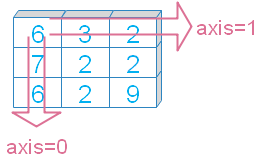Numpy std()
numpy.std(a, axis=None, dtype=None, out=None, ddof=0, keepdims=) a | array, elements to get the std value |
axis | Int (optional ), or tuple, default is None, stdvalue among all the elements. If axis given then values across the axis is returned. |
out | Optional. If given then output to be stored. Must be of same shape as of the output |
keepdims | Bool ( Optional ), output matches to the input array dimension. |
ddof | Delta Degrees of Freedom ( default is 0 ) , N - ddof is used where N is the number of elements in computing the standard deviation |
Sample array
You can use randint() to create an array for our examples. Or can use fixed elements to create the array.import numpy as np
# my_data=np.random.randint(2,high=7,size=(3,3),dtype='int16')
my_data=np.array([[6, 3, 2], [7, 2, 2], [6, 2, 9]])
print(my_data)[[6 3 2]
[7 2 2]
[6 2 9]]Axis
stdimum value of the elements across the axis.
print("std() : ", my_data.std())
print("std(axis=0) : ", my_data.std(axis=0))
print("std(axis=1) : ", my_data.std(axis=1))std() : 2.5385910352879693
std(axis=0) : [0.47140452 0.47140452 3.29983165]
std(axis=1) : [1.69967317 2.3570226 2.86744176]out
Alternative output array, must be of same shape as expected output. Let us first check with axis.keepdims
If it is set to True ( keepdims=True ) then it will take the dimension of input array.print("std(keepdims=True) : ", my_data.std(keepdims=True))
print("std(keepdims=False) : ", my_data.std(keepdims=False))std(keepdims=True) : [[2.53859104]]
std(keepdims=False) : 2.5385910352879693ddof
ddof = 0 ( default) , this is Population Standard Deviationddof = 1 , this is Sample Standard DeviationCheck this code with output.
import numpy as np
list1=[12,13,15,11,9,12,13,10,11,12,13,7,8]
my_data=np.array(list1)
print(my_data.std(ddof=0)) # 2.153846153846154
print(my_data.std(ddof=1)) # 2.2417941532712202Numpy mean() sum() max()

Subhendu Mohapatra
Author
🎥 Join me live on YouTubePassionate about coding and teaching, I publish practical tutorials on PHP, Python, JavaScript, SQL, and web development. My goal is to make learning simple, engaging, and project‑oriented with real examples and source code.
Subscribe to our YouTube Channel here
This article is written by plus2net.com team.
https://www.plus2net.com

 Python Video Tutorials
Python Video Tutorials